| Single Stops for Live Overhead |
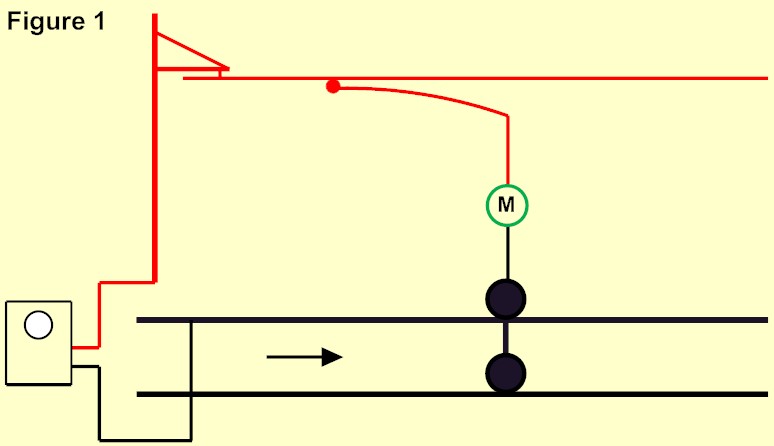
|
With two-rail wiring one rail is positive and the other is negative, but with live overhead both rails are negative and the overhead wire is positive. Figure 1 shows the simple wiring circuit from speed controller to tram.
When powered from the overhead wire, or two-rail, this system enables a tram to stop for a short time and then move off as the next tram approaches without the operator having any involvement.
|
When running trams from a live overhead, all wheels which have pickups are linked and both rails are also usually linked, but automatic tram stops are the exception to this, see diagrams below.
The motor in a tram powered from the overhead rotates the same way no matter which way the tram faces, so the tram has a front and if turned on the track will go the other way. This makes it possible to run two trams going in opposite directions from a single controller. Foxwood Park and Wearmouth can run four trams with two running in each direction and Beamish can run up to eight trams with four running in each direction on one controller.
In the following illustrations the overhead wire has been omitted, live rail and tram wheels are coloured red and dead / unpowered rail and tram wheels are coloured black and trams are represented by one axle only.
It is advisable to add a switched feed from the controller to the short rail so the automatic sections can be made live if needed. This is achieved using a simple on-off switch for figure 2 but for figures 3, 4 and 5 an On-Off-On switch is used with the track connected to the centre contact, the controller to one end contact and the switch section to the other end contact.
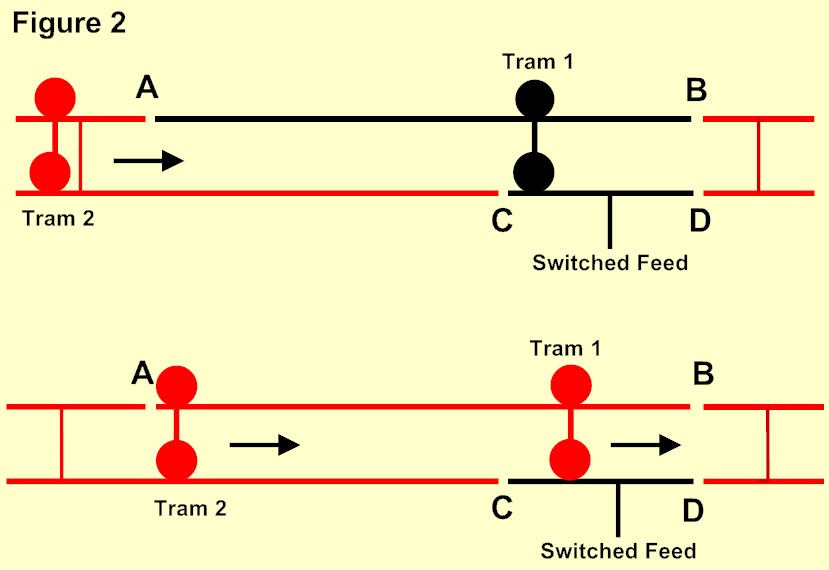
|
Figure 2 shows the track wiring for an automatic stop / start operation where one tram moves up behind a stationary tram which then moves off while the following tram stops.
This arrangement requires four cuts to be made at A, B, C and D in the running rails and the long and short rails do not need to be electrically connected but they can be.
|
This makes an unpowered section which can be whatever length is needed, usually AB should be as long as possible and CD slightly longer than one tram, to give it space to stop.
In Figure 2 as Tram 1 can run with only one rail live it continues past point A but stops when it gets to point C because both rails are now dead. When Tram 2 arrives at point A it acts as a switch and makes the long rail AB live so Tram 1 moves off on to normal live track. When Tram 2 arrives at point C the rails are again dead so it stops.
George Wilkinson used this method for the two automatic tram stops on his continuous Sealane O gauge tramway, where there are two automatic tram stops used, one for each direction, and on our Electric Avenue with its single automatic stop.
It was used on Beamish and Laxey Station to give the automatic move up in the fiddle yard on both tramways and on our end-to-end Sunderland Corporation Tramway where a shuttle timer with diodes on the end sections completed the automatic running.
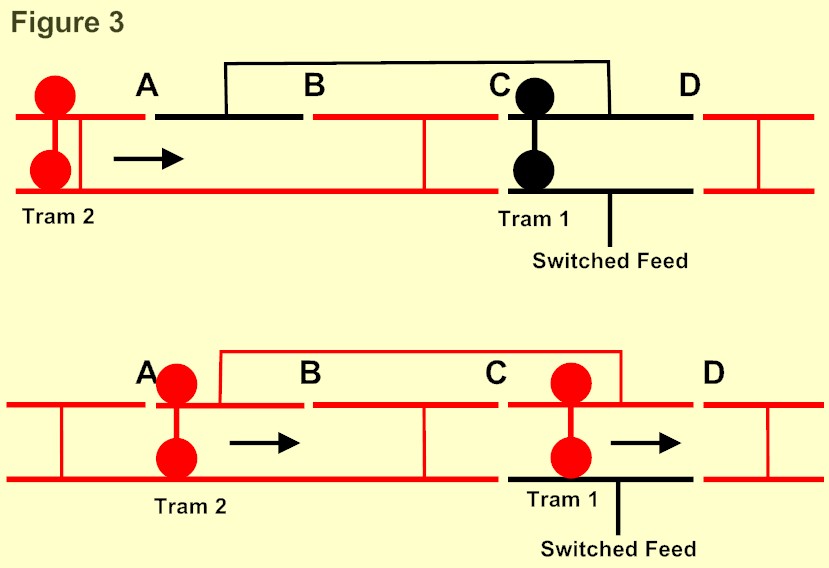
|
Figure 3 is a development of Figure 2 which allows a stationary tram to be started from a remote location and gives more flexibility of operation particularly where turnouts or crossovers are before the stop.
The greater the distance between AB and CD the longer is the time between tram 1 departing and tram 2 arriving at the stop.
|
It requires one rail to be cut at A and B and both rails to be cut at C and D. The rail at AB and CD needs to be electrically connected but unpowered and can be placed wherever required. Again section AB should as long as possible and CD slightly longer than one tram, to give it space to stop.
In Figure 3 rails AB and CD are joined electrically so that Tram 1 stops at point C where both rails are dead, but when Tram 2 arrives on rail AB it acts as a switch and makes rail CD live and Tram 1 moves off, as described above when Tram 2 arrives at point C it stops.
There are two automatic tram stops used in the passing loop on our and our Sunderland District Tramway which also uses a shuttle timer with diodes used at the ends with an additional diode used in the wire linking sections AB and CD so that the trams in the loop only leave going forwards.
| Remote Automatic Stop - Different Tracks |
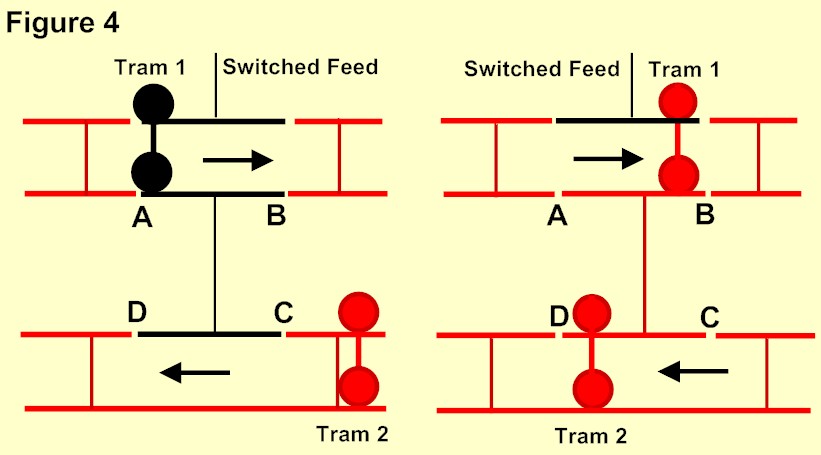
|
Figure 4 is a development of Figure 3 above which allows a stationary tram to be started by a tram going in the opposite direction on a different track and powered by the same controller.
The stop requires both rails to be cut at A and B and the switch section requires one rail to be cut at C and D on the other track. Section CD should as long as possible and section AB slightly longer than the longest tram to allow it to stop.
|
The rails at AB and CD need to be electrically connected but unpowered and the rail cuts can be made wherever required.
In Figure 4 Tram 1 stops at point A where both rails are dead, but when Tram 2 arrives on rail CD it acts as a switch and makes rail AB live and Tram 1 moves off but when the next tram arrives at point A it stops because the section is again dead.
This method was used for the four remote stops on Wearmouth, the Bank and Park stops on Beamish and the Station stops on Laxey Station.
| Automatic 90° (or Diamond) Crossing |
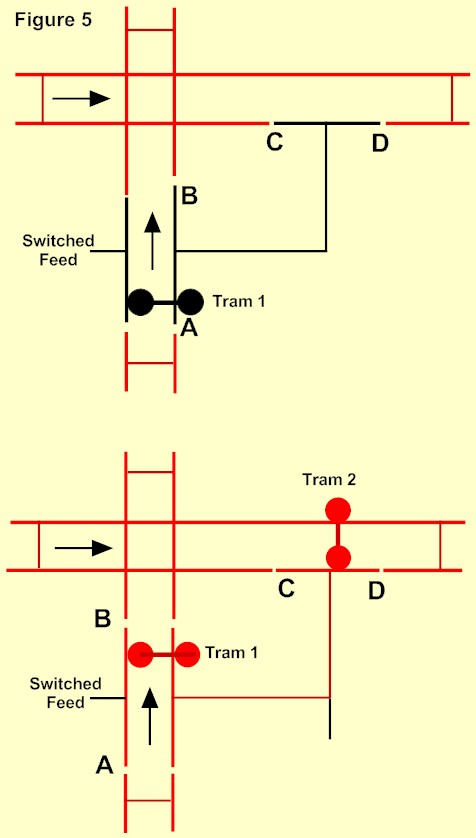
|
Figure 5 is another use ot the remote automatic stop technique used above and shows the rail cuts and electrical link needed to achieve the automatic control when Tram 2 has priority.
When Tram 1 gets to point A it stops (because section AB is unpowered) until Tram 2 arrives at C where it acts as a switch and makes section AB live.
When Tram 2 passes D section AB becomes dead again ready to stop the next tram. The positions of AB and CD should be far enough away from the crossing to give adequate clearance for the trams being used.
This application was added as a result of an enquiry from the Contact page asking if the technique could be used to prevent collisions at a single track 90° (or diamond) crossing,
|
Thiese explanations should help if you want to run trams prototypically from the overhead as an addition to your railway. If you have any questions about automatic tram stops, please use the Contact page to ask and you will get a reply.
© Grdon Bulmer 2024




